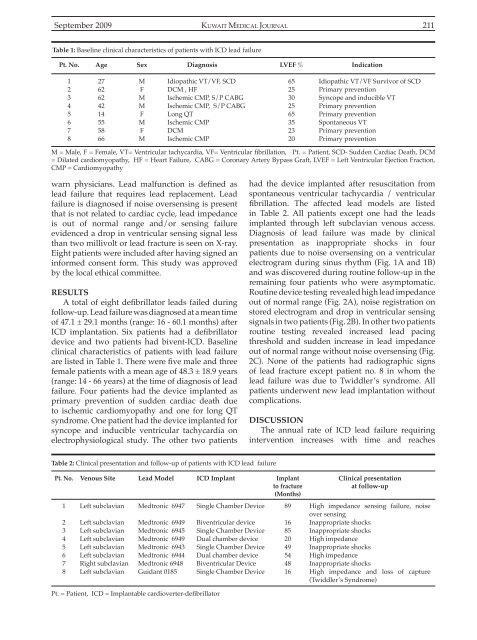Vol 41 # 3 September 2009 - Kma.org.kw
Vol 41 # 3 September 2009 - Kma.org.kw
Vol 41 # 3 September 2009 - Kma.org.kw
Create successful ePaper yourself
Turn your PDF publications into a flip-book with our unique Google optimized e-Paper software.
<strong>September</strong> <strong>2009</strong><br />
KUWAIT MEDICAL JOURNAL 211<br />
Table 1: Baseline clinical characteristics of patients with ICD lead failure<br />
Pt. No.<br />
Age<br />
Sex<br />
Diagnosis<br />
LVEF %<br />
Indication<br />
1<br />
2<br />
3<br />
4<br />
5<br />
6<br />
7<br />
8<br />
27<br />
62<br />
62<br />
42<br />
14<br />
55<br />
58<br />
66<br />
M<br />
F<br />
M<br />
M<br />
F<br />
M<br />
F<br />
M<br />
Idiopathic VT/VF, SCD<br />
DCM , HF<br />
Ischemic CMP, S/P CABG<br />
Ischemic CMP, S/P CABG<br />
Long QT<br />
Ischemic CMP<br />
DCM<br />
Ischemic CMP<br />
65<br />
25<br />
30<br />
25<br />
65<br />
35<br />
23<br />
20<br />
Idiopathic VT/VF Survivor of SCD<br />
Primary prevention<br />
Syncope and inducible VT<br />
Primary prevention<br />
Primary prevention<br />
Spontaneous VT<br />
Primary prevention<br />
Primary prevention<br />
M = Male, F = Female, VT= Ventricular tachycardia, VF= Ventricular fibrillation, Pt. = Patient, SCD- Sudden Cardiac Death, DCM<br />
= Dilated cardiomyopathy, HF = Heart Failure, CABG = Coronary Artery Bypass Graft, LVEF = Left Ventricular Ejection Fraction,<br />
CMP = Cardiomyopathy<br />
warn physicians. Lead malfunction is defined as<br />
lead failure that requires lead replacement. Lead<br />
failure is diagnosed if noise oversensing is present<br />
that is not related to cardiac cycle, lead impedance<br />
is out of normal range and/or sensing failure<br />
evidenced a drop in ventricular sensing signal less<br />
than two millivolt or lead fracture is seen on X-ray.<br />
Eight patients were included after having signed an<br />
informed consent form. This study was approved<br />
by the local ethical committee.<br />
RESULTS<br />
A total of eight defibrillator leads failed during<br />
follow-up. Lead failure was diagnosed at a mean time<br />
of 47.1 ± 29.1 months (range: 16 - 60.1 months) after<br />
ICD implantation. Six patients had a defibrillator<br />
device and two patients had bivent-ICD. Baseline<br />
clinical characteristics of patients with lead failure<br />
are listed in Table 1. There were five male and three<br />
female patients with a mean age of 48.3 ± 18.9 years<br />
(range: 14 - 66 years) at the time of diagnosis of lead<br />
failure. Four patients had the device implanted as<br />
primary prevention of sudden cardiac death due<br />
to ischemic cardiomyopathy and one for long QT<br />
syndrome. One patient had the device implanted for<br />
syncope and inducible ventricular tachycardia on<br />
electrophysiological study. The other two patients<br />
had the device implanted after resuscitation from<br />
spontaneous ventricular tachycardia / ventricular<br />
fibrillation. The affected lead models are listed<br />
in Table 2. All patients except one had the leads<br />
implanted through left subclavian venous access.<br />
Diagnosis of lead failure was made by clinical<br />
presentation as inappropriate shocks in four<br />
patients due to noise oversensing on a ventricular<br />
electrogram during sinus rhythm (Fig. 1A and 1B)<br />
and was discovered during routine follow-up in the<br />
remaining four patients who were asymptomatic.<br />
Routine device testing revealed high lead impedance<br />
out of normal range (Fig. 2A), noise registration on<br />
stored electrogram and drop in ventricular sensing<br />
signals in two patients (Fig. 2B). In other two patients<br />
routine testing revealed increased lead pacing<br />
threshold and sudden increase in lead impedance<br />
out of normal range without noise oversensing (Fig.<br />
2C). None of the patients had radiographic signs<br />
of lead fracture except patient no. 8 in whom the<br />
lead failure was due to Twiddler’s syndrome. All<br />
patients underwent new lead implantation without<br />
complications.<br />
DISCUSSION<br />
The annual rate of ICD lead failure requiring<br />
intervention increases with time and reaches<br />
Table 2: Clinical presentation and follow-up of patients with ICD lead failure<br />
Pt. No. Venous Site Lead Model ICD Implant Implant<br />
to fracture<br />
(Months)<br />
1<br />
2<br />
3<br />
4<br />
5<br />
6<br />
7<br />
8<br />
Left subclavian<br />
Left subclavian<br />
Left subclavian<br />
Left subclavian<br />
Left subclavian<br />
Left subclavian<br />
Right subclavian<br />
Left subclavian<br />
Medtronic 6947<br />
Medtronic 6949<br />
Medtronic 6945<br />
Medtronic 6949<br />
Medtronic 6943<br />
Medtronic 6944<br />
Medtronic 6948<br />
Guidant 0185<br />
Single Chamber Device<br />
Biventricular device<br />
Single Chamber Device<br />
Dual chamber device<br />
Single Chamber Device<br />
Dual chamber device<br />
Biventricular Device<br />
Single Chamber Device<br />
89<br />
16<br />
85<br />
20<br />
49<br />
54<br />
48<br />
16<br />
Clinical presentation<br />
at follow-up<br />
High impedance sensing failure, noise<br />
over sensing<br />
Inappropriate shocks<br />
Inappropriate shocks<br />
High impedance<br />
Inappropriate shocks<br />
High impedance<br />
Inappropriate shocks<br />
High impedance and loss of capture<br />
(Twiddler’s Syndrome)<br />
Pt. = Patient, ICD = Implantable cardioverter-defibrillator
















